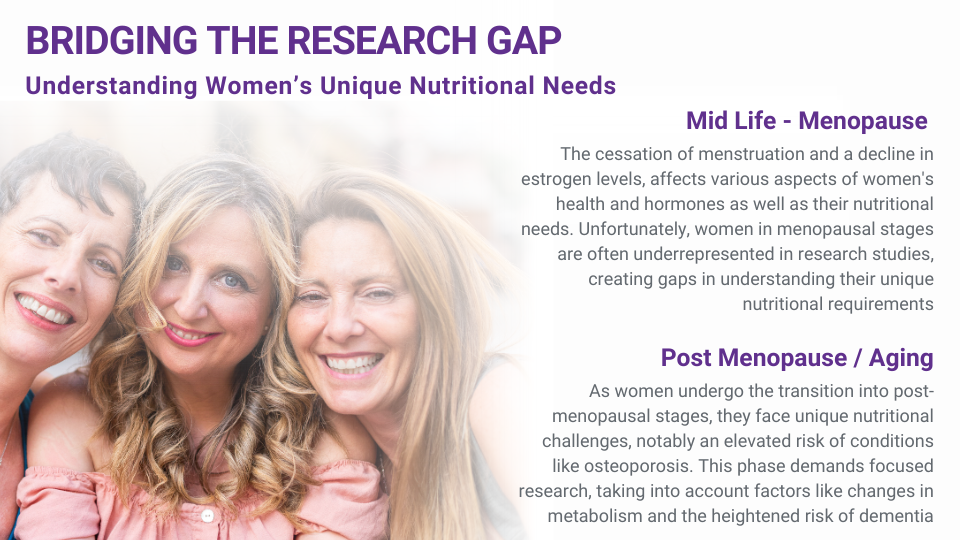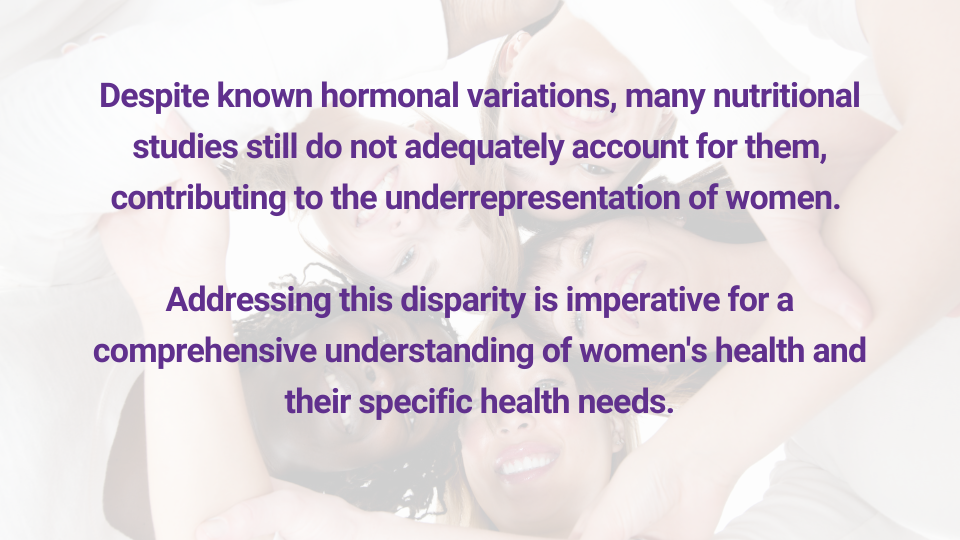The Pivotal Role and Representation of Diverse Women in Dietary Supplement Research Studies
Stephanie-Anne Girard, PhD., Lois Lin, PhD., Stephanie Recker, MSc., Katie Keene, BSc., Joshua Baisley BSc.
The landscape of clinical research has significantly evolved over the years, and one of the most notable changes is the increasing emphasis on diversity and inclusion. Prioritizing diversity in clinical trials ensures inclusivity and a broad representation of different perspectives, experiences, and biological variables (e.g., age, sex, weight, race, ethnicity, etc.), thereby enhancing the quality and applicability of research outcomes.1
In the realm of dietary supplement studies, the inclusion of women is particularly important. Women make up approximately half of the global population, and their biological and sex-based differences play a crucial role in shaping dietary habits and nutritional requirements.1 Physiological and hormonal differences must be considered to infer correct generalizations in observed outcomes. Furthermore, the concept of gender roles can have important implications for women’s health as well as the well-being of their families and communities. Women often serve as primary caregivers, influencing the dietary choices and nutritional status of their families.2
However, despite their critical role, the representation of women in nutritional research has historically been imbalanced and women have been significantly underrepresented in randomized controlled trials (RCTs). This discrepancy not only leads to skewed data and findings but goes against the validity of a RCT that does not accurately reflect the diverse health needs nor can be generalized to the female population.3
The inclusion of women in clinical research goes beyond achieving gender parity. Rather, it is imperative to gaining a comprehensive understanding of nutritional science, and ultimately, improving health outcomes for consumers.

Underrepresentation of Women in Nutritional Research
Nutritional research has been instrumental in understanding the complex relationship between diet and health. However, despite the significance of women's role in these studies, their representation is far from balanced.
It's also worth noting that the representation of women in nutritional research isn't uniform across different age groups and life stages. In mid-life, women face many changes referred to as menopause. Older women, particularly those in post-menopausal stages, are often underrepresented in studies. This is despite the fact that they face unique nutritional challenges, such as an increased risk of osteoporosis or changes in metabolism.7 Post-menopausal women often rely on the use of exogenous hormones (hormone-replacement therapy (HRT)), and this may impact pharmacokinetics making for a more complex analysis of study results and increases study costs.
Later in life, when ovarian function is almost at its end, issues associated with aging begin to occur, leading to various additional health concerns and nutritional needs. This particular group requires greater representation in clinical studies; however, participation and enrollment of elderly women in research studies may be confounded by the higher prevalence of dementia as compared to men. In fact, recent studies suggest that women have a higher incidence of Alzheimer’s Disease (up to twice the occurrence) than men. This impaired cognitive ability complicates the consenting process and may explain the lack of representation of these women.3
Women in Early-Stage Research Studies
Early-stage research studies, such as pharmacokinetics, play a crucial role in understanding how the body absorbs, distributes, metabolizes, and excretes various substances, including nutrients, supplements, and drugs.8 Despite potential sex-related differences, these studies have often overlooked the importance of including women.
Historically, pharmacokinetics studies have predominantly been conducted on male subjects, both human and animal. This gender bias stems from misconceptions that testing on male subjects is more straightforward due to the absence of hormonal fluctuations that occur in females.9 As a result, there is a significant lack of data on how women's bodies may react differently to various substances, which can lead to inaccuracies in dosage recommendations and potential adverse effects when applied to women.10 Additionally, women of child-bearing potential have been excluded from phase I trials because of the increased risk of fetal exposure during development. Although this approach considers the risk/benefit ratio, companies have purposely excluded women from these early-stage studies, emphasizing their participation in phase II and III trials.
This underrepresentation is not just a matter of fairness but also a significant scientific concern. Biological differences between sexes can impact the results of nutritional and pharmacokinetic studies. For instance, fluctuating levels of estradiol and progesterone during the female menstrual cycle can affect the metabolism of certain nutrients and drugs, which can significantly influence study outcomes.10 Varied pharmacokinetic responses can also come from women’s smaller body sizes and higher fat content even if there are no differences in metabolism.11
Recognizing this gap, some organizations have started to take action. The National Institutes of Health (NIH) in the U.S., for example, now requires that researchers consider sex as a biological variable in preclinical research.12 This policy aims to ensure that women are adequately represented in early-stage studies, leading to more accurate and applicable results.
Biological Differences and Their Impact on Nutritional Needs
The unique biological differences between sexes have a profound impact on nutritional needs. Women experience several physiological, neurological, and hormonal changes throughout their life stages, which can significantly influence nutrient metabolism and requirements.13
One of the most prominent factors is hormonal fluctuations.Pregnancy, lactation, and the various phases of the reproductive cycle all involve hormonal changes that can affect a woman's nutritional needs. For instance, during the menstrual cycle, serum zinc and magnesium concentrations decline and there is an increase in the prevalence of magnesium deficiency.14 Additionally, women may require more iron to compensate for the loss of blood during menstruation.15 Conversely, once regular blood loss stops during menopause, body iron stores can quickly build-up leading to an increased inflammatory status that can in turn exacerbate menopausal symptoms.16
Menopause, characterized by the cessation of menstruation and a decline in estrogen levels, affects various aspects of women's health, including their nutritional needs. The accelerated deterioration of bone tissue and subsequent loss of bone mineral density (osteopenia) following menopause, contributes to the increased risk for women to develop osteoporosis.17 Nutritional interventions such as calcium and vitamin D supplementation alongside lifestyle factors are currently being investigated to maintain bone health in post-menopausal women. The Women’s Health Initiative, the largest trial conducted in women’s health, changed the course of menopausal management especially regarding HRT and coronary heart disease.18 However, more than 20 years following its first article, there are still many unmet needs in menopausal care especially in alleviation of post-menopausal vasomotor symptoms (also referred to as hot flashes) without HRT use.19 Recent studies conducted with nutraceuticals and dietary supplements have demonstrated the relief of some menopausal symptoms such as hot flushes,20 sweating, and sleep problems21 in post-menopausal participants although more research is warranted.22,23
During pregnancy and lactation, the demand for micronutrients like calcium, folate, and vitamin D increases to support the growth and development of the fetus and newborn.24 Adequate protein intake is also essential to ensure fetal wellbeing while maintaining maternal homeostasis, preparing full-term delivery and lactation. Protein and amino acid intake requirements vary throughout the different gestational periods. The amount of protein deposited in maternal and fetal tissues gradually increases throughout the pregnancy with the most occurring during the third trimester.25 Animal studies suggest that threonine, lysine, isoleucine and tryptophan are indispensable amino acids with higher needs towards the later stages of pregnancy.26 Little is still known regarding amino acid requirements during pregnancy in humans.
Despite these known hormonal variations, many nutritional studies still do not adequately account for them. This can lead to generalized dietary recommendations that may not fully meet women's specific nutritional needs which is highly dependant on the life cycle stage.
Organizations like the National Institutes of Health (NIH), have recognized this gap and have started to implement policies that require researchers to consider sex as a biological variable in their studies.12 Such initiatives are an important step towards ensuring that research findings are applicable to both sexes and can cater to their unique nutritional needs.

Additional Pertinent Areas of Research for Women
Beauty-from-within is a movement that originates from Asia. In Japan, nutricosmetics, such as collagen, are commonly found in foods and beverages including tea, cookies, chocolate, coffee, and water.27 Over the past years, this concept has gained popularity in Europe and North America although there remains some skepticism regarding “beauty foods” and requirement of scientific backing for such claims.28
The term “nutricosmetics” implies the use of food supplements/natural health products to improve skin, hair and nails when ingested.29 The increased demand for cosmetic/beauty products and supplements predominantly targeted at women is mainly due to societal pressure and expectations surrounding female beauty standards. Despite the stereotype that skincare is primarily a woman's concern, significant advancements have been made in understanding skin health and the impact of various cosmetic ingredients on women.
The vaginal microbiome, dominated by Lactobacillus species in healthy women, plays a crucial role in protecting against genital tract infections and maintaining overall vaginal health.30 Emerging research suggests that diet and specific nutrients may influence the composition of the vaginal microbiome.31 Further research in this area can provide insights into how nutritional interventions can promote a healthy vaginal microbiome and contribute to women's health.
Irritable Bowel Syndrome (IBS) is a functional gastrointestinal disorder that is more prevalent in women.32 Symptoms can include abdominal pain, bloating, and altered bowel habits (constipation, diarrhea, alternate or mixed), which can significantly impact quality of life.33 Furthermore, women suffering from IBS report more symptoms related to mental health (e.g., fatigue, depression, and anxiety) and lower quality of life than men with IBS.32 These differences may be attributed to hormonal factors (e.g., hormonal fluctuations during the menstrual cycle in women, and hormonal difference between men and women), pain perception, gut microbiota, etc.32 Nutritional interventions, such as the low FODMAP diet, have shown promise in managing IBS symptoms.34 Understanding the role of diet in IBS management among women will be the key to developing personalized dietary strategies.
By focusing our efforts on these areas, we can ensure that women's unique nutritional needs are met, improving women's health outcomes and quality of life.
The Evolution of Diversity in Research, a Regulatory Priority
The U.S. Food and Drug Administration (FDA) has long recognized the importance of including diverse populations, including women, in clinical trials to ensure that medical products are safe and effective for everyone. This is reflected in their guidelines and policies.
In 1993, the NIH Revitalization Act was passed, which mandated the inclusion of women and minorities in National Institutes of Health (NIH)-funded clinical research.1 This was a significant step towards ensuring diversity in clinical trials.
The FDA further emphasized this in its 1993 guidance document, "Guideline for the Study and Evaluation of Gender Differences in the Clinical Evaluation of Drugs".35 This document provided recommendations on how to ensure appropriate representation of both sexes in clinical trials.
In 2014, the FDA launched its, "Action Plan to Enhance the Collection and Availability of Demographic Subgroup Data".36 The plan aims to improve the completeness and quality of demographic data collection, reporting, and analysis; identify barriers to subgroup enrollment in clinical trials and employ strategies to encourage greater participation; and make demographic subgroup data more available and transparent.
In 2018, the FDA released the draft guidance document on considerations for including pregnant women in clinical trials. Given the complexity of ensuring both the maternal and fetal well-being, clinical trials in pregnant populations should be carefully conducted with scientific and ethical considerations. This guidance document provides recommendations about how and when to include pregnant women in clinical trials for the development of drugs and biological products.
Another draft guidance document was released by FDA in 2019 to discuss the considerations for conducting clinical lactation studies. The need for conducting such studies is decided on a case-by-case basis, but the main goal of these studies is to evaluate the safety of a drug when used by lactating women. In this guidance document, FDA provided some recommendations to facilitate the conduct of lactation studies.
In 2020, the FDA released the final guidance, "Enhancing the Diversity of Clinical Trial Populations — Eligibility Criteria, Enrollment Practices, and Trial Designs".37 This document provides recommendations on how sponsors can increase enrollment of underrepresented populations in their clinical trials and broaden eligibility criteria to better reflect the population who will use the product.
These initiatives demonstrate the FDA's commitment to promoting diversity in clinical trials, ensuring clinical trial participants’ safety and well-being, recognizing that research findings can vary significantly between different population groups, and that it's crucial that medical products are tested in the people they are intended to treat.
In Europe, the EU Clinical Trials Regulation No 536/2014 was another important initiative that lists specific population groups likely to use the investigational product to be included in the clinical study. Provisions to include pregnant and breastfeeding women in clinical trials are included in this new legal directive.3
In the past recent years, Health Canada developed strategies to address the differential needs based on sex differences. This initiative emanated in the late 90's over concerns on the lack of research on breast and reproductive cancers and the exclusion of women in clinical trials. Health Canada developed the policy, “Canadian Guidance Document on the Inclusion of Women in Clinical Trials” which aims to address the differential needs of men and women and eventually applied “Sex and Gender-Based Analysis Plus” (SGBA Plus).38 This analytical process considers identity factors (sex, gender, age, race, ethnicity, socioeconomic status, disability, sexual orientation, etc.), histories, power relations, distribution of resources and individuals’ lived realities for conducting inclusive health research.39
While many of these guidelines and regulations were developed for drugs and biologics, they provide insight for design and conduct of dietary supplement clinical trials.
Conclusion
The underrepresentation of women in nutritional clinical research continues to be a significant issue that needs to be addressed. It's crucial for the scientific community to recognize and rectify this imbalance to ensure that the health needs of women are accurately represented and understood.
It is important to address the inadequate inclusion of women in all stages of research, including early-stage pharmacokinetics studies. With a balanced representation, we can advance our understanding of nutritional science and ensure that absorption, safety and efficacy of nutraceuticals are adequately evaluated in both sexes. By doing this, we allow for detection of clinically significant sex-related differences in the way men and women respond to them.
While women's participation in nutritional research has improved over the years, there is still much work to be done. More comprehensive representation of women in nutritional research can lead to breakthroughs in understanding their unique nutritional needs and challenges at different stages of their lives. This includes understanding how hormonal fluctuations affect nutrient metabolism, the specific nutritional requirements during menstruation, menopause, and how nutrition impacts conditions more prevalent in women.
A balanced representation of women in research would lead to a more nuanced understanding of women's health issues beyond commonly studied areas helping to combat stereotypes and misconceptions about women's health and nutrition, leading to more effective supplements.
Moving Forward
While there has been advances toward increased representation of women in clinical research, due in part, to regulatory changes and consumer demand, we strive to continue this progress with our Sponsors.
At Nutrasource, we believe that in addition to increasing representation of women in clinical research, and ensuring the study population is representative of the product indication and the target market, investigating how outcomes are impacted by the sex/gender of the participant is of utmost importance. Great consideration is given when planning and designing our clinical trials, including, but not limited to, accounting for factors such as absorption and metabolism that may be influenced by sex related biological differences in the selected study population. To account for variation, we often implement design, analytical and statistical techniques and controls, where warranted. These may include stratification factors in randomization, sex/gender-based subgroup analysis, and inclusion of sex/gender as a covariate in our statistical modeling.
About the authors
1. In: Mastroianni AC, Faden R, Federman D, editors. Women and Health Research: Ethical and Legal Issues of Including Women in Clinical Studies: Volume I. Washington (DC)1994.
2. Kurz KM, Johnson-Welch C. Enhancing Women's Contributions to Improving Family Food Consumption and Nutrition. Food and Nutrition Bulletin. 2001;22(4):443-53.
3. Daitch V, Turjeman A, Poran I, Tau N, Ayalon-Dangur I, Nashashibi J, et al. Underrepresentation of women in randomized controlled trials: a systematic review and meta-analysis. Trials. 2022;23(1):1038.
4. Viner RM, Cole TJ. Who changes body mass between adolescence and adulthood? Factors predicting change in BMI between 16 year and 30 years in the 1970 British Birth Cohort. Int J Obes (Lond). 2006;30(9):1368-74.
5. Smith ES, McKay AKA, Kuikman M, Ackerman KE, Harris R, Elliott-Sale KJ, et al. Auditing the Representation of Female Versus Male Athletes in Sports Science and Sports Medicine Research: Evidence-Based Performance Supplements. Nutrients. 2022;14(5).
6. Garthe I, Maughan RJ. Athletes and Supplements: Prevalence and Perspectives. Int J Sport Nutr Exerc Metab. 2018;28(2):126-38.
7. Silva TR, Oppermann K, Reis FM, Spritzer PM. Nutrition in Menopausal Women: A Narrative Review. Nutrients. 2021;13(7).
8. Anderson GD. Gender differences in pharmacological response. Int Rev Neurobiol. 2008;83:1-10.
9. Zucker I, Prendergast BJ. Sex differences in pharmacokinetics predict adverse drug reactions in women. Biol Sex Differ. 2020;11(1):32.
10. Soldin OP, Mattison DR. Sex differences in pharmacokinetics and pharmacodynamics. Clin Pharmacokinet. 2009;48(3):143-57.
11. Merkatz RB, Temple R, Subel S, Feiden K, Kessler DA. Women in clinical trials of new drugs. A change in Food and Drug Administration policy. The Working Group on Women in Clinical Trials. N Engl J Med. 1993;329(4):292-6.
12. Miller VM, Rocca WA, Faubion SS. Sex Differences Research, Precision Medicine, and the Future of Women's Health. J Womens Health (Larchmt). 2015;24(12):969-71.
13. Feskens EJM, Bailey R, Bhutta Z, Biesalski HK, Eicher-Miller H, Kramer K, et al. Women's health: optimal nutrition throughout the lifecycle. Eur J Nutr. 2022;61(Suppl 1):1-23.
14. Aguree S, Murray-Kolb LE, Diaz F, Gernand AD. Menstrual Cycle-Associated Changes in Micronutrient Biomarkers Concentration: A Prospective Cohort Study. Journal of the American Nutrition Association. 2023;42(4):339-48.
15. Milman N. Anemia--still a major health problem in many parts of the world! Ann Hematol. 2011;90(4):369-77.
16. Pasricha SR, Tye-Din J, Muckenthaler MU, Swinkels DW. Iron deficiency. Lancet. 2021;397(10270):233-48.
17. Sozen T, Ozisik L, Basaran NC. An overview and management of osteoporosis. Eur J Rheumatol. 2017;4(1):46-56.
18. Manson JE, Chlebowski RT, Stefanick ML, Aragaki AK, Rossouw JE, Prentice RL, et al. Menopausal hormone therapy and health outcomes during the intervention and extended poststopping phases of the Women's Health Initiative randomized trials. Jama. 2013;310(13):1353-68.
19. Lewis V. Undertreatment of menopausal symptoms and novel options for comprehensive management. Curr Med Res Opin. 2009;25(11):2689-98.
20. Imhof M, Gocan A, Imhof M, Schmidt M. Soy germ extract alleviates menopausal hot flushes: placebo-controlled double-blind trial. Eur J Clin Nutr. 2018;72(7):961-70.
21. Rattanatantikul T, Maiprasert M, Sugkraroek P, Bumrungpert A. Efficacy and Safety of Nutraceutical on Menopausal Symptoms in Post-Menopausal Women: A Randomized, Double-Blind, Placebo-Controlled Clinical Trial. J Diet Suppl. 2022;19(2):168-83.
22. Trimarco V, Rozza F, Izzo R, De Leo V, Cappelli V, Riccardi C, et al. Effects of a new combination of nutraceuticals on postmenopausal symptoms and metabolic profile: a crossover, randomized, double-blind trial. Int J Womens Health. 2016;8:581-7.
23. Shafie M, Homayouni Rad A, Mohammad-Alizadeh-Charandabi S, Mirghafourvand M. The effect of probiotics on mood and sleep quality in postmenopausal women: A triple-blind randomized controlled trial. Clin Nutr ESPEN. 2022;50:15-23.
24. King JC. Physiology of pregnancy and nutrient metabolism. Am J Clin Nutr. 2000;71(5 Suppl):1218S-25S.
25. Elango R, Ball RO. Protein and Amino Acid Requirements during Pregnancy. Adv Nutr. 2016;7(4):839S-44S.
26. Ball R, Moehn S, Pluske J, Pluske J. Feeding pregnant sows for optimum productivity: past, present and future perspectives. Manipulating pig production XIV Corowa (Australia): Australasian Pig Science Association. 2013:151-69.
27. Gunn L, Creasy P. Nutritional supplements to bring out beauty from within. 2017.
28. Dini I, Laneri S. Nutricosmetics: A brief overview. Phytother Res. 2019;33(12):3054-63.
29. Dini I. The Potential of Algae in the Nutricosmetic Sector. Molecules. 2023;28(10).
30. Ma B, Forney LJ, Ravel J. Vaginal microbiome: rethinking health and disease. Annu Rev Microbiol. 2012;66:371-89.
31. Barrientos-Duran A, Fuentes-Lopez A, de Salazar A, Plaza-Diaz J, Garcia F. Reviewing the Composition of Vaginal Microbiota: Inclusion of Nutrition and Probiotic Factors in the Maintenance of Eubiosis. Nutrients. 2020;12(2).
32. Kim YS, Kim N. Sex-Gender Differences in Irritable Bowel Syndrome. J Neurogastroenterol Motil. 2018;24(4):544-58.
33. Heitkemper MM, Chang L. Do fluctuations in ovarian hormones affect gastrointestinal symptoms in women with irritable bowel syndrome? Gend Med. 2009;6 Suppl 2(Suppl 2):152-67.
34. Staudacher HM, Whelan K. The low FODMAP diet: recent advances in understanding its mechanisms and efficacy in IBS. Gut. 2017;66(8):1517-27.
35. Food US, Drug A. Guideline for the study and evaluation of gender differences in the clinical evaluation of drugs; notice. Fed Regist. 1993;58(139):39406-16.
36. Administration USFaD. FDA action plan to enhance the collection and availability of demographic subgroup data. 2014.
37. Administration USFaD. Enhancing the Diversity of Clinical Trial Populations — Eligibility Criteria, Enrollment Practices, and Trial Designs Guidance for Industry. 2020.
38. Canada H. Health Portfolio Sex- and Gender-Based Analysis Plus Policy: Advancing Equity, Diversity and Inclusion. 2023.
39. Yakerson A. Women in clinical trials: a review of policy development and health equity in the Canadian context. Int J Equity Health. 2019;18(1):56.
 Skip to main content
Skip to main content







